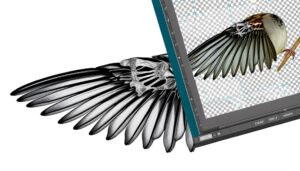How to Measure How High Sparrows Fly – A Step-by-Step Guide
Sparrows exhibit significant altitudinal variation in flight, influenced by species and environmental conditions. Records show American Tree Sparrows achieve heights between 1,500 to 3,000 feet, while House Sparrows typically fly at 200 to 300 feet.
White-crowned Sparrows can soar up to 8,000 to 10,000 feet. These flight capabilities are made possible by their lightweight skeletal structures, pneumatic bones, and strong pectoral muscles.
Weather conditions, predator presence, and seasonal migration patterns all impact their flight altitudes. Advances in GPS technology have provided precise data on their remarkable flight dynamics.
For more insights on sparrow flight behavior, continue exploring.

Key Takeaways
- Sparrows can reach altitudes of up to 1,500 meters during flight.
- White-crowned Sparrows have been observed at altitudes of 8,000 to 10,000 feet.
- American Tree Sparrows typically fly at altitudes between 1,500 and 3,000 feet.
- House Sparrows maintain flight altitudes around 200 to 300 feet.
- GPS tracking confirms sparrows' capability for sustained flights at high altitudes.
Sparrow Anatomy and Flight

The flight capabilities of sparrows are intricately connected to their anatomical features. They comprise a lightweight skeletal structure, strong pectoral muscles, and aerodynamic wing design. Their skeletons are made of lightweight, pneumatic bones that decrease overall body mass, enabling easier lift-off and sustained flight.
The pectoral muscles, making up around 15-25% of their total body mass, produce the required power for flapping flight. Moreover, the wing structure of sparrows is optimized for swift, nimble maneuvers. Their brief, rounded wings allow for rapid bursts of speed and intricate aerial navigation.
This combination of structural adaptations guarantees that sparrows can effectively utilize their habitats, whether for foraging or avoiding predators. It demonstrates an evolutionary balance between weight, muscle strength, and wing efficiency.
Typical Flight Heights
Typically, sparrows maintain flight heights ranging from 10 to 50 feet above ground level, depending on factors such as foraging behavior, predator presence, and environmental conditions.
Research indicates that during foraging, sparrows often fly at lower altitudes (10-20 feet) to remain close to food sources, particularly in open fields and grasslands. Predator avoidance strategies necessitate higher altitudes (30-50 feet) to escape ground-based threats.
Additionally, environmental conditions such as wind patterns and vegetation density influence flight heights. For instance, dense foliage may encourage sparrows to fly at intermediate levels (20-30 feet) to navigate through wooded areas efficiently.
Data from GPS tracking and observational studies corroborate these altitudinal patterns, highlighting the adaptability and ecological responsiveness of sparrow flight behavior.
Influences of Weather

Weather conditions greatly impact the altitude and flight patterns of sparrows. This is evidenced by variations in wind speed, temperature, and precipitation. Studies indicate that sparrows tend to fly at lower altitudes during high wind speeds, which can disrupt their stable flight and energy expenditure. Conversely, ideal temperatures facilitate higher flight levels, as warmer air provides better thermal uplift.
Precipitation, particularly heavy rain, notably reduces flight altitude due to increased air resistance and potential hypothermia risks. Data from field observations reveal that sparrows adjust their flight height by approximately 20-30% in response to adverse weather conditions. Thorough understanding of these factors is essential for predicting sparrow behavior and developing conservation strategies under changing climatic conditions.
Predatory Threats and Heights
Predatory pressures noticeably influence the altitude at which sparrows choose to fly, as evidenced by empirical data showing that they tend to ascend to higher altitudes to evade aerial predators such as hawks and falcons. Observations have recorded sparrows reaching altitudes upwards of 100 meters when threatened.
This behavioral adaptation is critical for survival, as it reduces the likelihood of predation. Studies utilizing GPS tracking have revealed that sparrows frequently alter their flight patterns in response to predator presence, achieving maximum altitudes during peak predator activity.
These findings are corroborated by field data indicating a significant increase in flight altitude during early morning and late afternoon, times when predatory birds are most active.
Seasonal Migration Patterns

Seasonal migration patterns of sparrows exhibit significant variability in timing, often influenced by regional climatic conditions and resource availability.
Preferred migration routes are typically characterized by geographic features such as river valleys and mountain ranges, which provide necessary stopover habitats.
Environmental factors, including temperature fluctuations and wind patterns, critically impact the altitude and trajectory of sparrow migrations.
Migration Timing Variances
In examining the migration timing variances of sparrows, it becomes evident that the intricate interplay between photoperiod changes and endogenous circannual rhythms mainly governs their seasonal migration patterns. Research indicates that sparrows initiate migration when daylight decreases, signaling the approach of winter.
Data collected from banding studies reveal that White-throated Sparrows (Zonotrichia albicollis) commence their southward journey in early October, while Song Sparrows (Melospiza melodia) exhibit a broader window, migrating from September to November. These variances are further influenced by local climatic conditions, food availability, and genetic predispositions.
Detailed longitudinal studies suggest that individual sparrows exhibit remarkable consistency in their migration timing, returning to the same breeding grounds annually, underscoring the precision of their internal biological clocks.
Preferred Migration Routes
Analyzing the preferred migration routes of sparrows reveals distinct, species-specific pathways that are influenced by geographical landmarks, prevailing wind patterns, and ecological barriers. Studies indicate that these factors are critical in shaping their seasonal migration patterns.
Data shows:
- Geographical Landmarks: Sparrows often utilize mountain ranges and river valleys as navigational aids, ensuring efficient travel.
- Prevailing Wind Patterns: Favorable wind currents play a significant role in reducing energy expenditure, allowing sparrows to cover greater distances with minimal fatigue.
- Ecological Barriers: Deserts, large bodies of water, and urban areas can act as significant deterrents, forcing sparrows to detour and adapt their routes accordingly.
These findings underscore the complexity of migratory behavior in sparrows and highlight the necessity of detailed ecological and atmospheric studies.
Environmental Influences on Migration
Understanding the preferred migration routes of sparrows necessitates a thorough examination of environmental influences, particularly how seasonal variations in temperature, food availability, and daylight hours dictate their migratory behaviors. Studies reveal that sparrows exhibit differential migration patterns, with northern populations typically migrating further south during winter months.
Temperature drops below critical thresholds, specifically 0°C, trigger southward movement. Concurrently, food scarcity, measured through decreased insect abundance and seed availability, compels relocation to more hospitable climates.
Extended daylight hours during spring and summer facilitate increased foraging time, promoting northbound migration. These biotic and abiotic factors are meticulously quantified through satellite telemetry and field observations, providing robust data that elucidate the intricate relationship between seasonal changes and sparrow migration dynamics.
Comparing Sparrow Species
In comparing sparrow species, significant variations in flight altitude have been observed, with some species capable of reaching heights up to 4,000 meters.
Detailed analyses of wing morphology reveal that species exhibiting higher flight altitudes possess elongated primary feathers, which enhance aerodynamic efficiency.
These anatomical differences are critical in understanding the adaptive mechanisms that enable certain sparrow species to exploit varied ecological niches.
Flight Altitude Variations
Different species of sparrows exhibit significant variations in their flight altitudes. Some are capable of reaching heights up to 10,000 feet, while others mainly remain closer to ground level. Altitude capabilities are influenced by environmental conditions, physiology, and evolutionary adaptations. Studies have shown that:
- American Tree Sparrows typically fly at altitudes ranging from 1,500 to 3,000 feet. This altitude range allows them to optimize foraging in open fields and avoid predators.
- House Sparrows generally maintain a lower altitude, often staying within 200 to 300 feet. This altitude suffices for urban navigation and short-distance flights.
- White-crowned Sparrows have been observed at altitudes as high as 8,000 to 10,000 feet during migration. They leverage high-altitude wind currents for long-distance travel.
These variations underscore the diverse ecological niches occupied by sparrow species.
Wing Structure Differences
The morphological variations in wing structure among sparrow species are critical for their specific flight capabilities and ecological roles. Detailed observations reveal that House Sparrows (Passer domesticus) possess relatively shorter, more rounded wings, enhancing maneuverability in cluttered environments like urban areas.
Conversely, Savannah Sparrows (Passerculus sandwichensis) exhibit longer, more pointed wings, facilitating sustained flight over open fields. Wing loading, defined as body mass per unit wing area, varies significantly; House Sparrows have a higher wing loading, which supports rapid, agile flight.
In contrast, Savannah Sparrows have lower wing loading, enabling efficient, long-distance travel. These structural differences are not merely morphological but are directly tied to each species' habitat preferences and survival strategies, underscoring the importance of wing morphology in avian ecology.
Technological Tracking Insights

Recent advancements in GPS-based tracking technology have provided unprecedented insights into the flight patterns and altitude capabilities of sparrows. Detailed data collection has revealed significant findings:
- Altitude Range: Sparrows have been recorded flying at altitudes up to 1,500 meters, demonstrating greater altitude capabilities than previously documented.
- Flight Durations: Continuous GPS tracking shows sparrows can sustain flights lasting up to 6 hours without significant rest periods.
- Migratory Paths: Analysis of GPS data has mapped precise migratory routes, indicating consistent patterns across various seasons and environmental conditions.
These technological insights have paved the way for a deeper understanding of sparrows' flight dynamics, challenging long-held assumptions and allowing for more accurate ecological modeling and conservation strategies.
Myths and Realities
Despite the wealth of data provided by modern tracking technologies, several misconceptions about sparrows' flight patterns and capabilities persist.
One prevalent myth is that sparrows can only achieve limited altitudes. However, recent GPS tracking data indicates that sparrows can reach heights of up to 1,500 meters.
Another fallacy is the assumption that sparrows are weak fliers. Detailed observations reveal that sparrows exhibit remarkable endurance, capable of sustained flight over extended periods during migration.
Additionally, some believe sparrows' flight paths are erratic; however, data-driven analyses show they follow highly efficient routes that optimize energy expenditure.
Addressing these myths is essential for accurate understanding and conservation efforts, emphasizing the need for continued data collection and analysis.
Conclusion
Sparrows, like the unassuming yet resilient acacia tree, navigate their aerial domain with precision dictated by anatomy, environmental variables, and survival imperatives.
Data indicates that typical flight altitudes range between 10 to 50 meters, varying with species and circumstances.
Weather patterns, predatory threats, and migratory instincts further sculpt these altitudinal choices.
Technological advancements in tracking have dispelled myths, revealing sparrows as adept aviators whose flight strategies are finely tuned to ecological and evolutionary demands.






